Answer the following :- In Fig. 6.13(i) the man walks 2 m carrying a mass of 15 kg on his hands. In Fig. 6.13(ii), he walks the same distance pulling the rope behind him. The rope goes over a pulley, and a mass of 15 kg hangs at its other end. In which case is the work done greater ?
 Solution in Punjabi
Solution in Punjabi
Step by step video & image solution for Answer the following :- In Fig. 6.13(i) the man walks 2 m carrying a mass of 15 kg on his hands. In Fig. 6.13(ii), he walks the same distance pulling the rope behind him. The rope goes over a pulley, and a mass of 15 kg hangs at its other end. In which case is the work done greater ? by Physics experts to help you in doubts & scoring excellent marks in Class 11 exams.
Updated on:21/07/2023Topper's Solved these Questions
Similar Questions
Can mechanical waves travel through vacuum?
View SolutionThe pulley arrangements of Figs. (a) and (b) are identical. The mass of the rope is negligible. In (a) the mass m is lifted up by attaching a mass 2m to the other end of the rope. In (b), m is lifted up by pulling the other end of the rope with a constant downward force F=2mg. The acceleration of m is the same in both cases

View SolutionAnswer the following:
a) The casing of a rocket in flight burns up due to friction. At whose expense is the heat required for burning obtained? The rocket or the atmosphere?
b) Comets move around the sun in highly elliptical orbits. The gravitational force on the comet due to the sun is not normal to the comet's velocity in general. Yet the work done by the gravitatonal force over every complete orbit of the comet is zero. Why?
c) An artificial satellite orbiting the earth in very atmosphere loses its energy grdually due to dissipation against atmospheric resistance, howerver small. Why then does its speed increase progressively as it comes closer and closer tothe earth? d)In fig i) the man walks 2m carrying a mass of 15 kg on his hands. In Fig ii) he walks the same distance pulling the rope behind him. The rope goes over pulley, and a mass of 15 kg hangs at its other end. In which case is the work done greater?
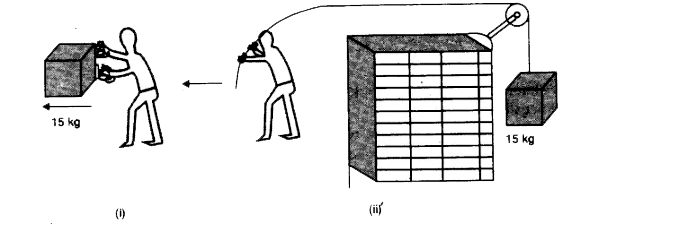
View SolutionA man of mass m stands on a frame of mass M. He pulls on a light rope, which passes over a pulley. The other end of the rope is attached to the frame. For the system to be in equilibrium, what force must the man exert on the rope?
View SolutionAnswer the following:
a) The casing of a rocket in flight burns up due to friction. At whose expense is the heat required for burning obtained? The rocket or the atmosphere?
b) Comets move around the sun in highly elliptical orbits. The gravitational force on the comet due to the sun is not normal to the comet's velocity in general. Yet the work done by the gravitatonal force over every complete orbit of the comet is zero. Why?
c) An artificial satellite orbiting the earth in very atmosphere loses its energy grdually due to dissipation against atmospheric resistance, howerver small. Why then does its speed increase progressively as it comes closer and closer tothe earth? d)In fig i) the man walks 2m carrying a mass of 15 kg on his hands. In Fig ii) he walks the same distance pulling the rope behind him. The rope goes over pulley, and a mass of 15 kg hangs at its other end. In which case is the work done greater?

View Solutionचित्र (a ) में एक व्यक्ति अपने हाथो में 15 किग्रा का कोई द्रव्यमान लेकर 2 मीटर चलता है। चित्र (b ) में वह उतनी ही दुरी अपने पीछे रस्सी को खींचते हुए चलता है। रस्सी घिरनी पर चढ़ी हुई है और उसके दूसरे सिरे पर 15 किग्रा का द्रव्यमान लटका हुए है। परिकलन कीजिए की किस स्थिति में किया गया कार्य अधिक है?
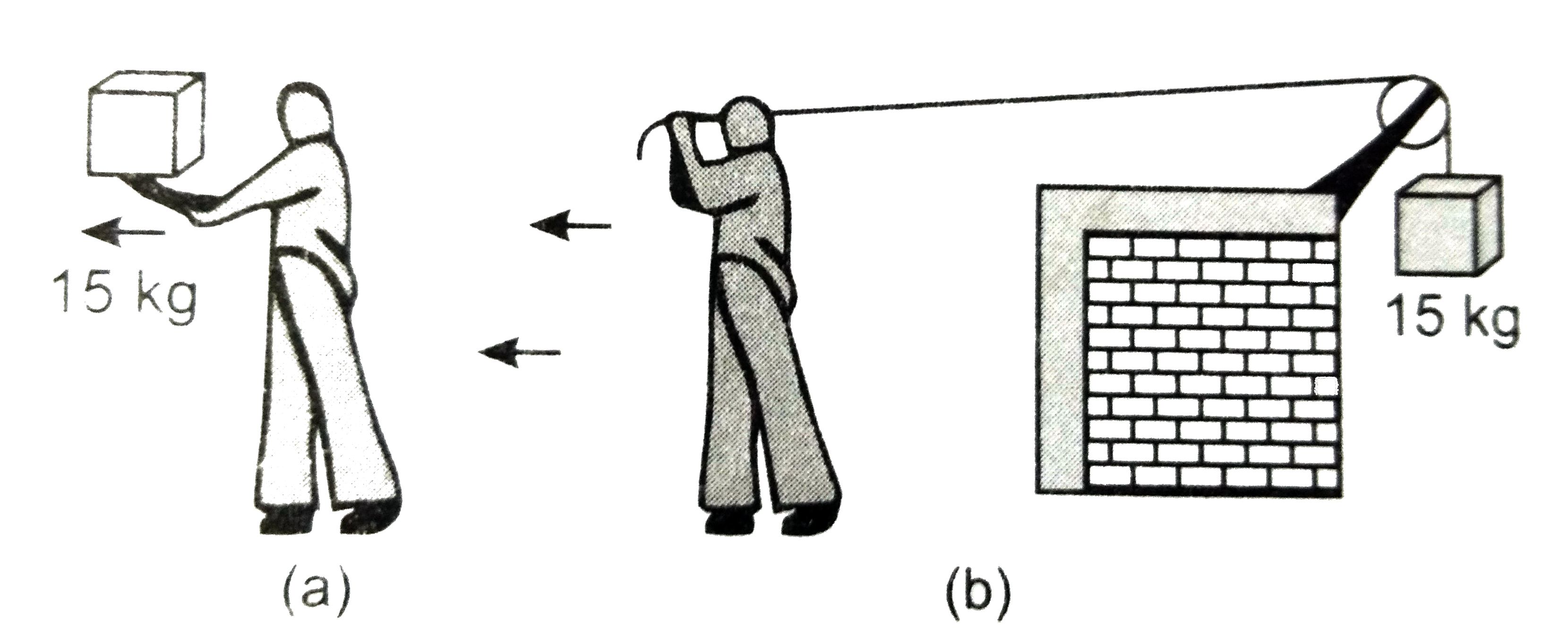
View Solutionनिम्नलिखित का उत्तर दीजिए -
चित्र ( i ) में एक व्यक्ति अपने हाथों में 15 kg का कोई द्रव्यमान लेकर 2m चलता है । चित्र ( ii ) में वह उतनी ही दूरी अपने पीछे रस्सी को खींचते हुए चलता है । रस्सी घिरनी पर चढ़ी हुई है और उसके दूसरे सिरे पर 15 kg का द्रव्यमान लटका हुआ है । परिकलन कीजिए कि किस स्थिति में किया गया कार्य अधिक है ?
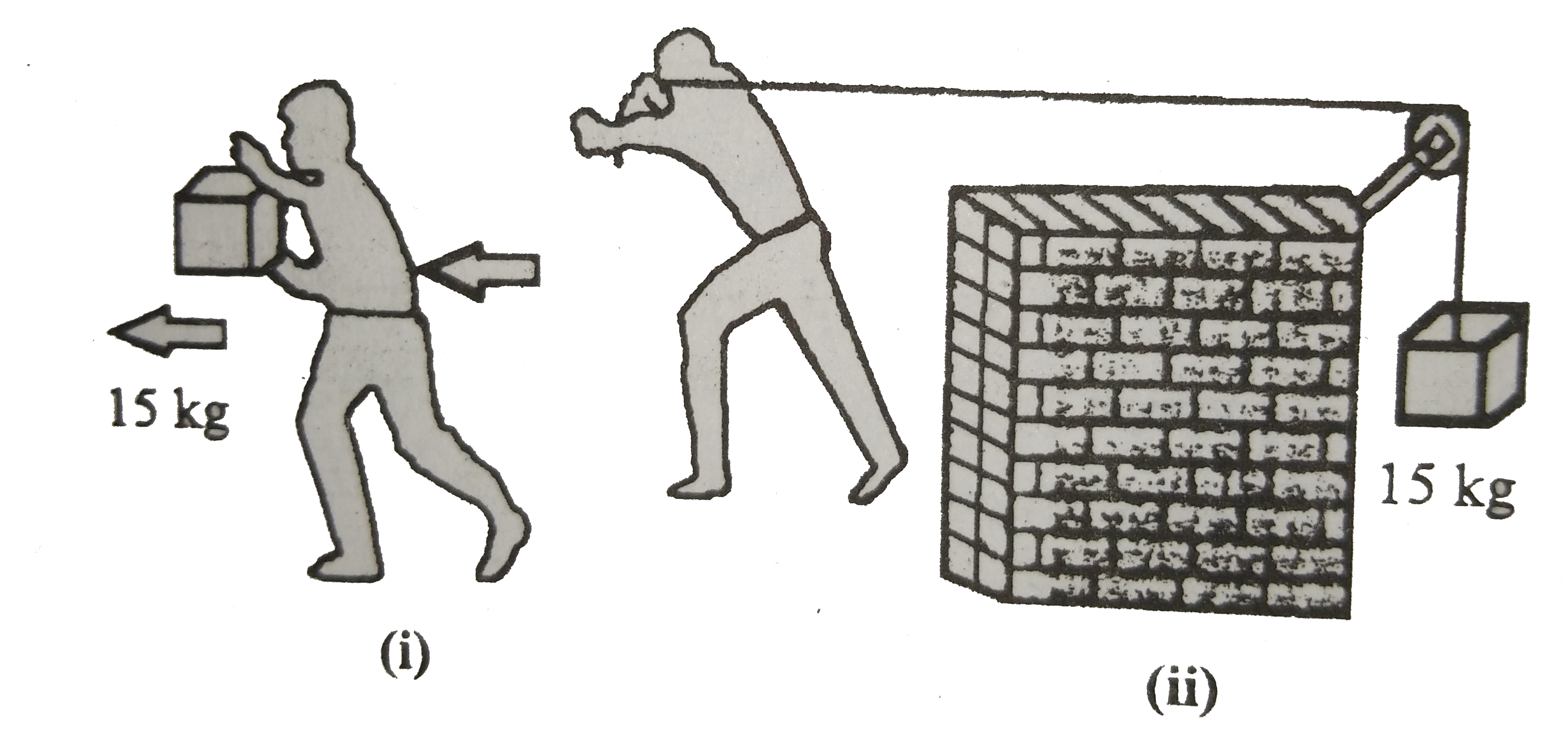
View SolutionThe pulley arrangement of fig. are identical. The mass of the rope is negligible. In (a) mass m is lifted up by attaching a mass (2 m) to the other end of the rope. In (b), m is lifted up by pulling the other end of the rope with a constant downward force F =2 mg. In which case, the acceleration of m is more ?
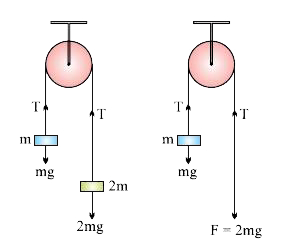
View Solutionएक व्यक्ति अपने हाथो में 15 kg का कोई द्रव्यमान लेकर 2 m चलता है |किया गया कार्य परिकलन कीजिए
View Solutionवह उतनी ही दूरी अपने पीछे रस्सी को खींचते हुए चलता है | रस्सी घिरनी पर चढ़ी है और उसके दूसरे सिरे पर 15 kg का द्रव्यमान लटका हुआ है | दोनों स्थितियों में कार्य का परिकलन कीजिए | (g=10m/s2 लीजिये )
View Solutionनिम्नलिखित का उत्तर दीजिये -
(a) किसी रॉकेट का बाह्य आवरण उड़ान के दौरान घर्षण के कारण जल जाता है। जलने के लिए आवश्यक उष्मीय ऊर्जा किसके व्यय पर प्राप्त की गई-राकेट या वातावरण ?
(b) धूमकेतु सूर्य के चारों ओर बहुत ही दीर्घवृत्तीय कक्षाओं में घूमते हैं। साधारणतया धूमकेतु पर सूर्य का गुरुत्वीय बल धूमकेतु के लंबवत् नहीं होता हैं। फिर भी धूमकेतु की संपूर्ण कक्षा में गुरुत्वीय बल द्वारा किया गया कार्य शुन्य होता हैं। क्यों?
(c) पृथ्वी के चारों ओर बहुत ही क्षीण वायुमण्डल में घूमते हुए किसी कृतिम उपग्रह की ऊर्जा धीरे-धीरे वायुमण्डल प्रतिरोध (चाहे यह कितना ही कम क्यों न हो) के विरुद्ध क्षय के कारण कम हो होती जाती है फिर भी जैसे-जैसे कृतिम उपग्रह पृथ्वी के समीप आता है तो उसकी चाल में लगातार वृद्धि क्यों होती हैं ?
(d) चित्र (i) में एक व्यक्ति अपने हाथों में 15 kg का कोई द्रव्यमान लेकर 2 m चलता है। चित्र (ii) में वह उतनी ही दूरी अपने पीछे रस्सी को खींचते हुए चलता है। रस्सी घिरनी पर चढ़ी हुई है और उसके दूसरे सिरे पर 15 kg का द्रव्यमान लटका हुआ है। परिकलन कीजिए कि किस स्थिति में किया गया कार्य अधिक है ?
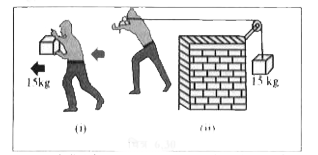
View SolutionAnswer the following : In Fig.6.13. (i) the man walks 2m carrying a mass of 15kg on his hands. In Fig. 6.13. (ii), he walks the same distance pulling the rope behind him. The rope goes over a pulley, and a mass of 15 kg hangs at its other end. In which case is the work done greater?
View SolutionAnswer the following : In Fig.6.13. (i) the man walks 2m carrying a mass of 15kg on his hands. In Fig. 6.13. (ii), he walks the same distance pulling the rope behind him. The rope goes over a pulley, and a mass of 15 kg hangs at its other end. In which case is the work done greater?
View SolutionAnswer the following :
In Fig.6.13. (i) the man walks 2m carrying a mass of 15kg on his hands. In Fig. 6.13. (ii), he walks the same distance pulling the rope behind him. The rope goes over a pulley, and a mass of 15 kg hangs at its other end. In which case is the work done greater?
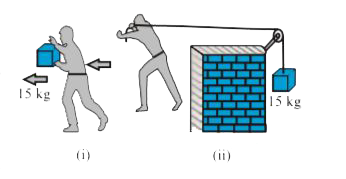
View SolutionIn figure (i) the man walks 2 m carrying a mass of 15 kg on his hands .In figure (ii) , he walks the same distance pulling the rope behind him . The rope goes over a pulley , and a mass of 15 kg hangs at its other end . In which case is the work done greater ?
View SolutionIn fig. (i) the man walks 2 m carrying a mass of 15 kg on his hands. In Fig. (ii) , he walks the same distance pulling the rope behind him. The rope goes over a pulley, and a mass of 15 kg hangs as its other end. In which case is the work done greater ?
View Solution
